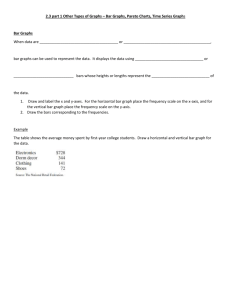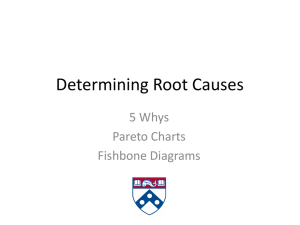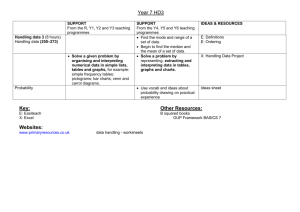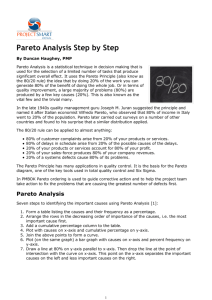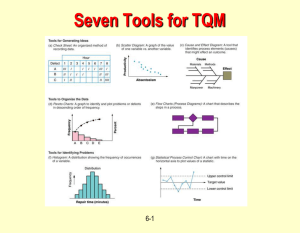Continual process improvement – A road map
advertisement
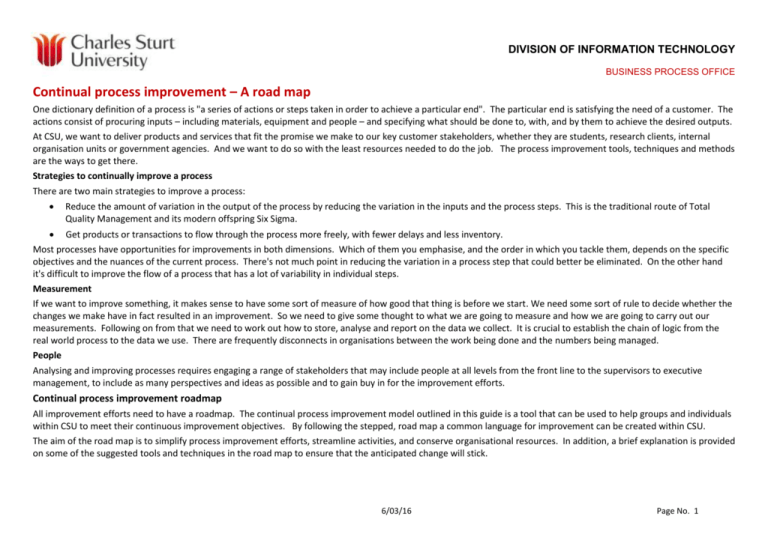
DIVISION OF INFORMATION TECHNOLOGY BUSINESS PROCESS OFFICE Continual process improvement – A road map One dictionary definition of a process is "a series of actions or steps taken in order to achieve a particular end". The particular end is satisfying the need of a customer. The actions consist of procuring inputs – including materials, equipment and people – and specifying what should be done to, with, and by them to achieve the desired outputs. At CSU, we want to deliver products and services that fit the promise we make to our key customer stakeholders, whether they are students, research clients, internal organisation units or government agencies. And we want to do so with the least resources needed to do the job. The process improvement tools, techniques and methods are the ways to get there. Strategies to continually improve a process There are two main strategies to improve a process: Reduce the amount of variation in the output of the process by reducing the variation in the inputs and the process steps. This is the traditional route of Total Quality Management and its modern offspring Six Sigma. Get products or transactions to flow through the process more freely, with fewer delays and less inventory. Most processes have opportunities for improvements in both dimensions. Which of them you emphasise, and the order in which you tackle them, depends on the specific objectives and the nuances of the current process. There's not much point in reducing the variation in a process step that could better be eliminated. On the other hand it's difficult to improve the flow of a process that has a lot of variability in individual steps. Measurement If we want to improve something, it makes sense to have some sort of measure of how good that thing is before we start. We need some sort of rule to decide whether the changes we make have in fact resulted in an improvement. So we need to give some thought to what we are going to measure and how we are going to carry out our measurements. Following on from that we need to work out how to store, analyse and report on the data we collect. It is crucial to establish the chain of logic from the real world process to the data we use. There are frequently disconnects in organisations between the work being done and the numbers being managed. People Analysing and improving processes requires engaging a range of stakeholders that may include people at all levels from the front line to the supervisors to executive management, to include as many perspectives and ideas as possible and to gain buy in for the improvement efforts. Continual process improvement roadmap All improvement efforts need to have a roadmap. The continual process improvement model outlined in this guide is a tool that can be used to help groups and individuals within CSU to meet their continuous improvement objectives. By following the stepped, road map a common language for improvement can be created within CSU. The aim of the road map is to simplify process improvement efforts, streamline activities, and conserve organisational resources. In addition, a brief explanation is provided on some of the suggested tools and techniques in the road map to ensure that the anticipated change will stick. 6/03/16 Page No. 1 DIVISION OF INFORMATION TECHNOLOGY BUSINESS PROCESS OFFICE Continual process improvement – A road map 1. Select an 2. improvement opportunity Bill Black Fran Brown Bob Grey Amy Tan Ian Blew Customers waiting too long to be served. 6. Standardise and monitor New rosters published Improved procedures documented Customer feedback monitored 7. Review improvement strategy Need for training in customer service skills Need for training in data collection Form a team 5. Study the results Review focus group results Review customer handling times Review adequacy of staffing levels 8. Plan for the future Use of computers to improve customer handing procedures Form a team? 6/03/16 3. Analyse the current situation Too few staff at peak times Customer handling processes inadequate Too few seats in waiting area 4. Take improvement action Improve staff rosters Simplify procedures Improve seating Create customer focus groups Continuous process improvement is an ongoing cycle seeking incremental improvement over time. Processes are constantly evaluated and improved in the light of their efficiency, effectiveness and flexibility. This means returning back to Step 1 of this Road Map and start the cycle once more. Page No. 2 DIVISION OF INFORMATION TECHNOLOGY BUSINESS PROCESS OFFICE Activity 1. Select an improvement opportunity 2. Form a team 3. Analyse the current situation 4. Take improvement action Purpose Tools Select and prioritise improvement opportunities Review process – are there existing process-work goals? Ensure process goal linked to business strategy Survey internal-external customers, consider customer needs to help identify where value can be added, or time, money and energy reduced Identify key activities/role/functions/customers – touch points with other groups or individuals - Brainstorming - Graphs - Process flow chart - Customer feedback, interviews, surveys Agree on improvement team’s key roles and responsibilities Appoint an (external) Process facilitator, Process team leader Process Facilitator briefs team on process improvement tools and methods To describe the problem-opportunity – test assumptions To identify any immediate improvements to be made To collect and analyse any available data on aspects of the current situation to understand the problem-opportunity Use data to establish a target or process goal To develop a current situation As Is process map that reflects actual work flow Identify next in-house-user or customer requirements Identify multiple methods of performing the process if there is more than one Identify process constraints - Check lists - Process maps - Flow charting - Graphs - Pareto charts - Cause and effect diagrams To develop and implement an Action Plan(address the who, what, when, where, how and why) To re-design the process or process flow to better add value to the flow of activities, better meet the needs of the customer or interested parties Plan and implement action to improve process or resolve the problem Agree and make process or process flow changes Create a draft To Be process map To select the monitoring measures - Check lists - Graphs - Pareto charts - Cause and effect diagrams 6/03/16 Page No. 3 DIVISION OF INFORMATION TECHNOLOGY BUSINESS PROCESS OFFICE Activity 5. Study the results 6. Standardise and monitor solution Purpose Confirm the action(s) taken achieved the target Determine if the process has been improved, confirm level of effectiveness Did the results correspond or confirm expectations Identify the reasons target was met or not met are understood Analyse constraints What additional actions are required (if target not met) - Check lists - Process maps - Control chart - Graphs - Histogram Plan for change to make it stick, identify change management issues Team establishes, clear and measurable process measures Create end of line measures that are important to the customer Insert measures with their goals at critical junctures (hand over points, i.e., between function/roles) in the process map Everyone understands the new process Revised methods and procedures published Training on new process took place. Periodic review points established Areas for replication considered - Change management planning - Check lists - Control chart - Graphs - Histogram Review the outcomes and outputs against original goals, objectives and targets Review the strengths and weaknesses of the entire process improvement activity and the team activities To schedule and conduct period process review (s) Results documented and feedback provided to stakeholders. All aspects of the process improvement, task and team activities evaluated for their effectiveness. Team’s personal and professional development needs identified and addressed. Process improvement efforts celebrated - Check lists - Flow chart - Control chart - Pareto chart - Run chart 7. Review improvement strategy Tools 6/03/16 Page No. 4 DIVISION OF INFORMATION TECHNOLOGY BUSINESS PROCESS OFFICE Activity 8. Plan for the future – Embrace continuous improvement Purpose Tools Review of the means established to monitor the process and identify future improvement to the process Plan further to address any remaining process problems and opportunities Review lessons learned relating to problem solving skills and group dynamics Institute periodic reviews of the performance of the process (include in future management reviews, quality plans) Ensure that actions are in place to lock in and maintain the gains that have been realised. Ensure that a process of continual process review and improvement is established. Ensure that a process exist for gathering and evaluating other opportunities from the team’s findings 6/03/16 - Brainstorming - Process improvement storyboarding Page No. 5 DIVISION OF INFORMATION TECHNOLOGY BUSINESS PROCESS OFFICE Improvement Tools and Techniques Flow Charts Often the first step to understanding or improving a process is to draw a flowchart. A process cannot be improved, unless every team member understands and agrees on what the process is. A flowchart is a pictorial summary of the various steps of a system or process. It helps to clarify what the system or process does in order to clarify problems or improvement opportunities. A flow chart helps in identifying: Suppliers and customers for each step in the process; Where critical measurements can be taken to monitor what the system/process is doing; Redundant steps and re-work (loops) in the process. To find more out above this valuable process mapping tool, please use the following link to discover how to contrast the actual versus the ideal flow of a process to identify improvement opportunities. Run (Trend) Charts Measurement A run chart is perhaps the simplest of the statistical data tools, being a line graph showing change in data over time. A run chart is used to study the behaviour of a single characteristic, to detect trends or patterns in data which may develop over a period of time. Run charts are very simple to make: The horizontal axis is always time related. The vertical axis is the scale of measurement of the characteristic. Typical procedures for constructing a run chart include: Scale the horizontal axis for the time period of the analysis. Scale and label the vertical axis to cater for the maximum expected value. Plot each data value as a point at the appropriate time. Join each point to the previous point for easy interpretation Time 6/03/16 Page No. 6 DIVISION OF INFORMATION TECHNOLOGY BUSINESS PROCESS OFFICE Check Sheets A check sheet is a simple tool for collecting or gathering attribute data, and presenting the data in a logical, organised ad readily understood manner. A check sheet is a simple tally of problems found, their numbers and locations. Check sheets can show patterns of problems so that they can be investigated and improved. The data of a check sheet can then be used in constructing the following charts: Pareto Charts Control charts How to use a check sheet: Clearly identify what is being observed - Events being observe should be clearly labelled Keep the data collection process as simple as possible - Collecting data should not be a job in itself Group the data - Data collected should be grouped in a way that makes the data valuable and reliable Be creative - Try to create a format that will give you the most information with the least amount of effort Pareto Chart Pronounced pah-ray-toe and named after an Italian Vilfredo Pareto who studied the distribution of wealth in Europe in the late 18th and early 19th centuries. Pareto concluded that 80% of the wealth was held by 20% of the population. Thus the ‘Pareto principle’ was born. A Pareto chart helps to determine which problems to solve and in what order. Drawing a Pareto chart based on information from check sheets (or other forms of data collection) helps direct attention to the most important problems. The idea is to work on the tallest bars of the chart, rather than tacking the smaller bars. A Pareto chart is used to separate the ‘vital few’ from the ‘trivial many’. Typical steps in a Pareto chart’s construction: Decide what is to be measured. Decide how the data will be gathered and classified. Total the number of times each problem occurs. Calculate the percentage total for each problem by either frequency or cost. Draw the horizontal and vertical axes. Mark intervals on horizontal axis, with the most frequently occurring problems on the left. Draw on the vertical bar the height of each bar corresponding to the percentage. Complete the graph by filling in the remaining data. 6/03/16 Page No. 7 DIVISION OF INFORMATION TECHNOLOGY BUSINESS PROCESS OFFICE Cause and Effect-Fishbone Diagrams Known as the ‘fishbone’ diagram because of its shape or the ‘Ishikawa diagram’ after its originator. The cause and effect diagram was developed to represent the relationship between some ‘effect’ and the possible ‘causes’. The effect or problem is stated on the right side of the diagram and the major influences or ‘causes’ are listed to the left. This diagram can be used in presentations to show progress. As problems are eliminated, they are removed from the fishbone. With a cause and effect diagram: Decide the effect to be analysed, being as precise as you can (eg. variation of...; late delivery of…). Involve people who are familiar with the process being improved. Draw the diagram, identifying possible causes using brainstorming techniques. ‘Cluster’ the causes into broad headings. Add further causes as they arise. Decide on the key cause or causes. Add twigs to the branches of the key cause or causes. Proceed to data collection analysis and solution development. Control Charts Upper and lower control limits are calculated by running a process untouched, taking samples and putting the averages of these samples into appropriate formula. Plotting these points on a chart will determine whether a point falls between or outside the calculated limits, or if it forms an unlikely pattern. If the point is outside the limits or an unlikely pattern appears, the process is said to be out of control. The fluctuation of the points within the limits results from variations built into the process. These result from common causes within the system. The points outside the limits are the result of special causes that are not part of the way the process normally operates. 6/03/16 Upper control limit - UCL Measurement # Defective A control chart is used to monitor, control and improve process performance over time by studying variation and its source. A control chart can identify whether the process being measured is statistically stable (in control). A control chart is a run chart with statistically determined upper and lower control limits. Average Lower control limit - LCL Time Page No. 8 DIVISION OF INFORMATION TECHNOLOGY BUSINESS PROCESS OFFICE Need more information?? Please contact the Business Process Office for further information at email – drop box address here: (bpo@csu.ed.au) or contact: Colm Cox, Colin Semmens, Manager, Business Process Office Tel: +61 2 6051 9709 Campus: Albury-Wodonga Email: ccox@csu.edu.au or Process Analyst, Business Process Office Tel: +61 2 6051 9442 Campus: Albury-Wodonga Email: csemmens@csu.edu.au 6/03/16 Page No. 9

